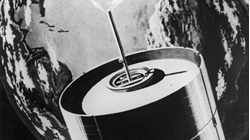- Register
- Log in to Tune-In
- Wishlist (0)
-
Shopping cart
(0)
You have no items in your shopping cart.
Remembering the groundbreaking Intel-1 satellite that brought the world The Beatles

You’ve heard news anchors introduce guests with the obligatory “joining us now via satellite,” for decades. That’s only possible because of the vast network of communications satellites currently in orbit around the earth.
The Intelsat-1, nicknamed Early Bird, pioneered this new era of global communication via space when it launched on April 6 1965. It was the first commercial satellite to be placed in geosynchronous orbit, which means it follows the daily rotation of the earth, albeit on a different inclination.
So, if you were observing the satellite from the ground it would appear to be in the same position. This is necessary to maintain continuous transmission, as the line of sight is never lost. Also due to the higher position in orbit, these satellites can cover and connect more of the earth.
Early Bird took full advantage, becoming the first satellite to enable constant satellite communication between Europe and North America. Phone calls, faxes and television broadcasts were all transmitted by the dinky satellite, which weighed just 34.5kg and measured a mere 76 x 61 cm. It featured just two 6W transponders with 50 MHz bandwidth and was covered with 6,000 solar cells.
After it was placed in service on June 28 of 1865 it was able to support the transmission of one television channel or 240 voice circuits at a time, but not both.
Source: Chris Smith
